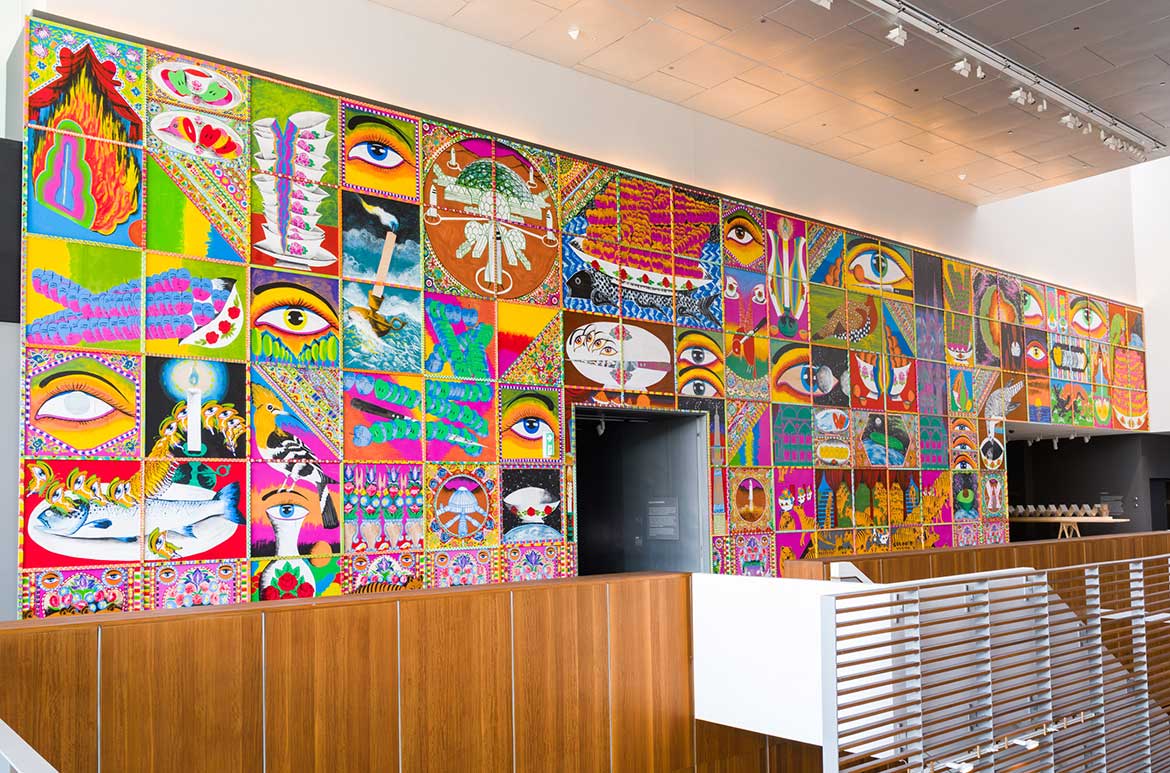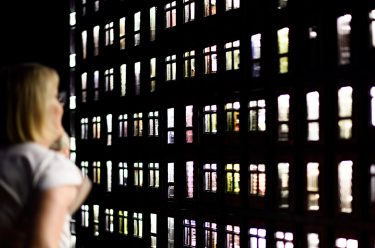Iman Raad’s large-scale mural Days of bliss and woe is a riot of colour and decoration. Together with the embroidered banners of Garden nights, these works were commissioned for ‘The 9th Asia Pacific Triennial of Contemporary Art’ (APT9) and Days of bliss and woe was acquired for the Collection. Steeped in art-historical references from across time and place, Raad’s works feature diverse themes and images from Persian folk arts, South Asian truck painting and Australian flora and fauna.
Watch | Iman Raad discusses ‘Days of bliss and woe’
The disparate imagery, bright colours and repetitive patterns of Iman Raad’s artworks make them hard to take in all at once. The painted, panelled mural Days of bliss and woe towers above the viewer on the upper walkway of the Gallery of Modern Art (GOMA); adjacent, suspended along the railing, is Garden nights — 26 vibrant embroidered velvet banners that hang down into the atrium and can be seen from the ground and second floors. Both works were commissioned by the Gallery for APT9 and share multiple themes and image references, allowing viewers to draw their own connections and construct their own narratives about the work.
Born in Iran, Raad taught himself design and ran his own small graphic design studio in Tehran. His calligraphic posters have been exhibited in international exhibitions and featured in Phaidon’s Graphic: 500 Designs that Matter (2017). Raad moved to the United States in 2013 to study painting and printmaking at the Yale School of Art. He and his partner, artist Shahrzad Changalvaee, now live in Brooklyn.1
‘Days of bliss and woe’ 2018 detail
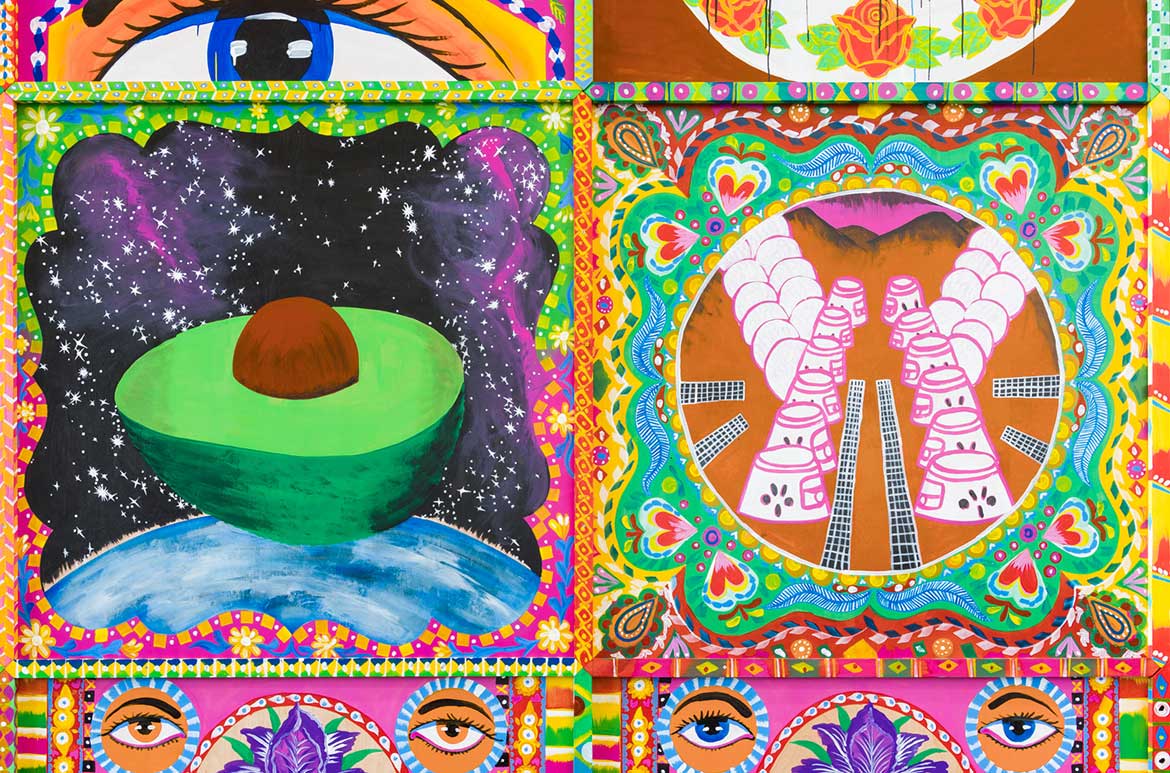
While Raad’s multifaceted interests inform his vibrant paintings and murals, the various — and at times fantastical — motifs he employs are often not strictly located in a particular time or place. By keeping the scenes unchained to specific eras or political contexts, the artist deliberately allows the viewer to create their own free associations. For example, is the avocado in orbit connected to the three different plans — by the European Union, NASA and Elon Musk — for colonising Mars that appear elsewhere in the mural? How does the headless NASA suit on the mural relate to the rose-covered rocket in the banners? Are we overthinking the artwork to observe that the minarets of Istanbul’s Sultan Ahmed Mosque (also known as the Blue Mosque) closely resemble the rocket? Raad links these images together through a sense of movement and themes of reproduction, exploration, colonisation and extinction, but he is quick to note that there are no dominant narratives in either of his two impressive commissions.
‘Garden nights’ 2018 detail

Iman Raad ‘Days of bliss and woe’ 2018
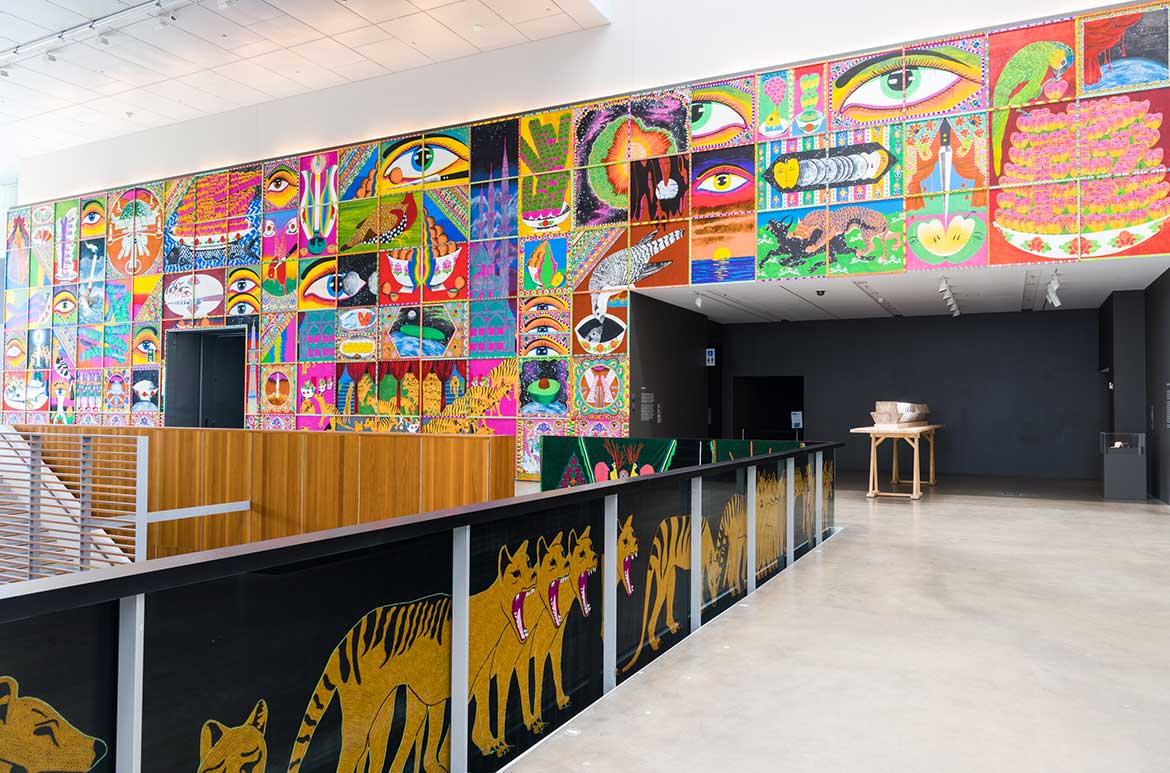
This sense of movement and reproduction can be seen in the morphing repetition of an apple that turns into a moon and back again and in the ever-multiplying bowl of apples. Raad uses glitch imagery and repetitive patterns to create images that are difficult to read upon first glance and which therefore require active looking. A technique often used by media artists, glitch imagery involves distorting an image by corrupting a digital file or manipulating hardware. Beyond the technological references, the repeated Tasmanian tigers in Garden nights mimic the dynamic procession of figures found in cave paintings or the friezes of ancient Greek architecture, designed to add drama within the larger composition. Raad uses repetition to create a sense of dynamism that draws the viewer’s eye across his large installations.
Raad’s works include a number of specific local references to Islamic symbolism and his Iranian heritage, such as the Imam Reza shrine, the world’s largest mosque complex, in his home city of Mashhad. The embroidered banners of Garden nights reference the flags that are prolifically displayed during annual Ashura festivities in Iran, when the Shiite population mourns the death of Imam Hussain, the grandson of the prophet Muhammad. The banners in APT9 were created by a group of artisans in Mashhad, who worked with Raad to adapt and transform his drawings into highly decorative tapestries that celebrate and mourn life and death in all its forms. Some banners are imbued with a sense of melancholy, such as in the repeated wide-eyed faces adrift in a dark sea — are they refugees? — or the figures who hang by their ankles. Others feature the cypress tree, an evergreen with a long lifespan, a symbol of eternality and immortality. The cypress tree has appeared in Persian art and literature since ancient times, most famously adorning Persepolis.
‘Days of bliss and woe’ detail
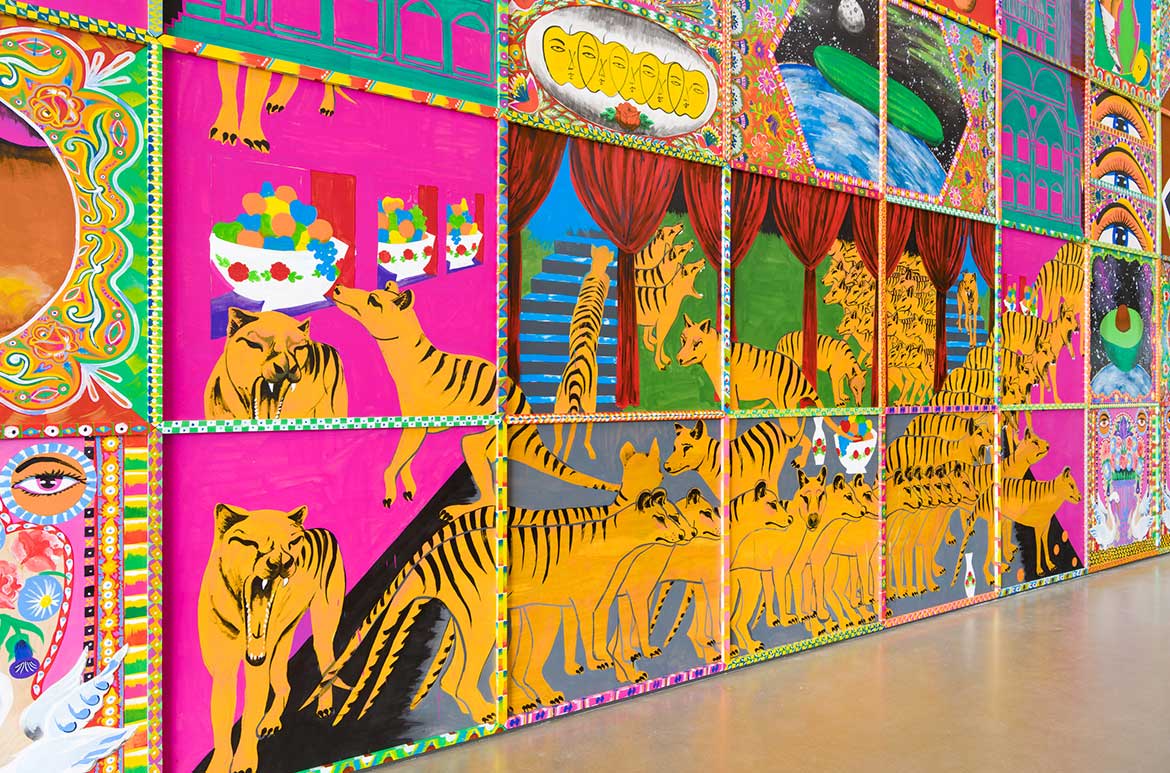
In addition, Raad also features a number of Australian references in these works, including the pandanus fruit and the now extinct thylacine (Tasmanian tiger). The thylacine reminds us of the folly of humans, who have hunted many of the world’s species to extinction, while the pandanus plant has populated north-eastern Australia, South East Asia and the Pacific, signalling the proximity and climatic similarity of these areas. While these elements are familiar for the local Queensland audience, the artist has painted them in a way that makes the objects strange. For instance, in one scene the thylacines hunt swans, and in another the pandanus floats on a starry background. Moreover, the artist was keen to include these recognisable elements because they create a starker contrast with the unfamiliar objects and symbols. At some point the audience comes face to face with the limits of their knowledge but are hopefully intrigued enough to seek out these new references.
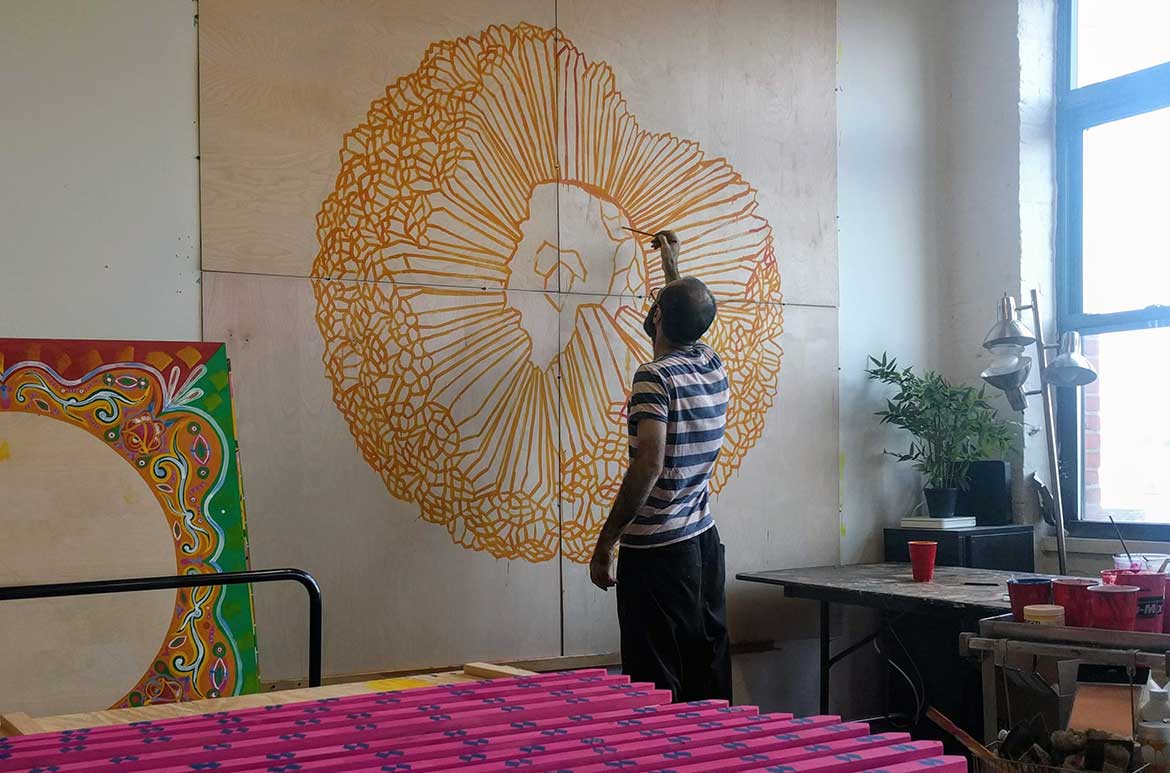
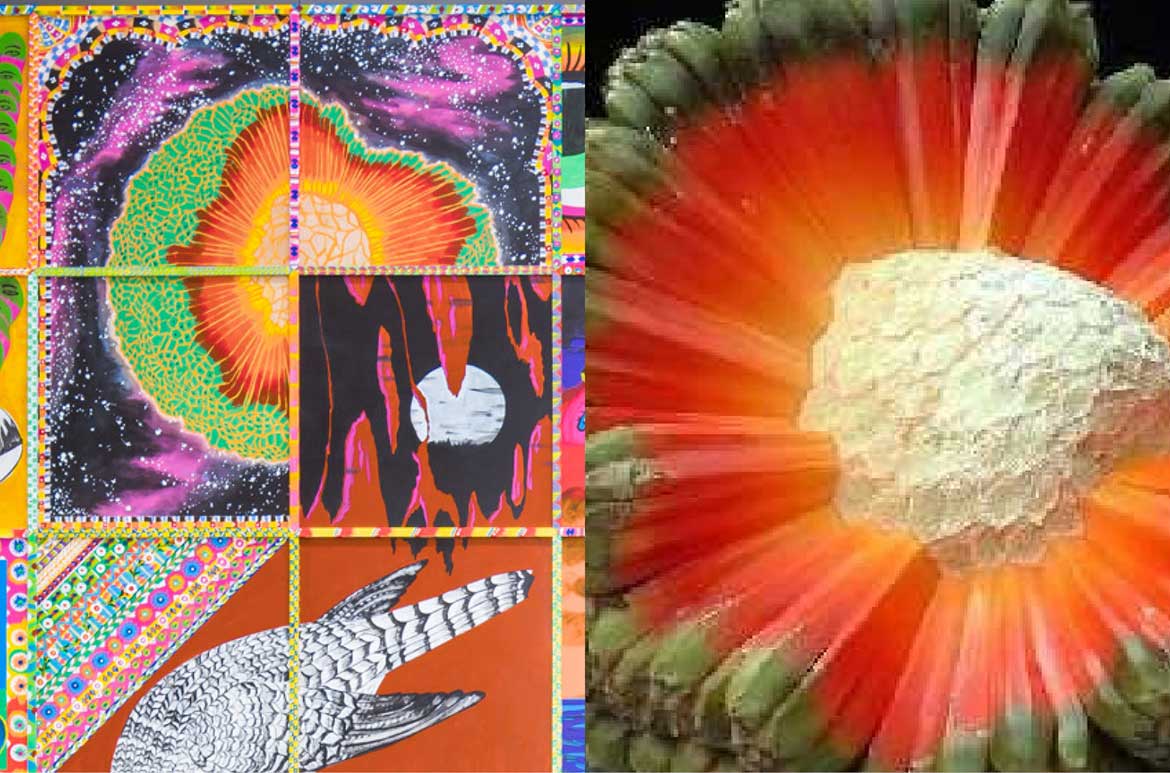
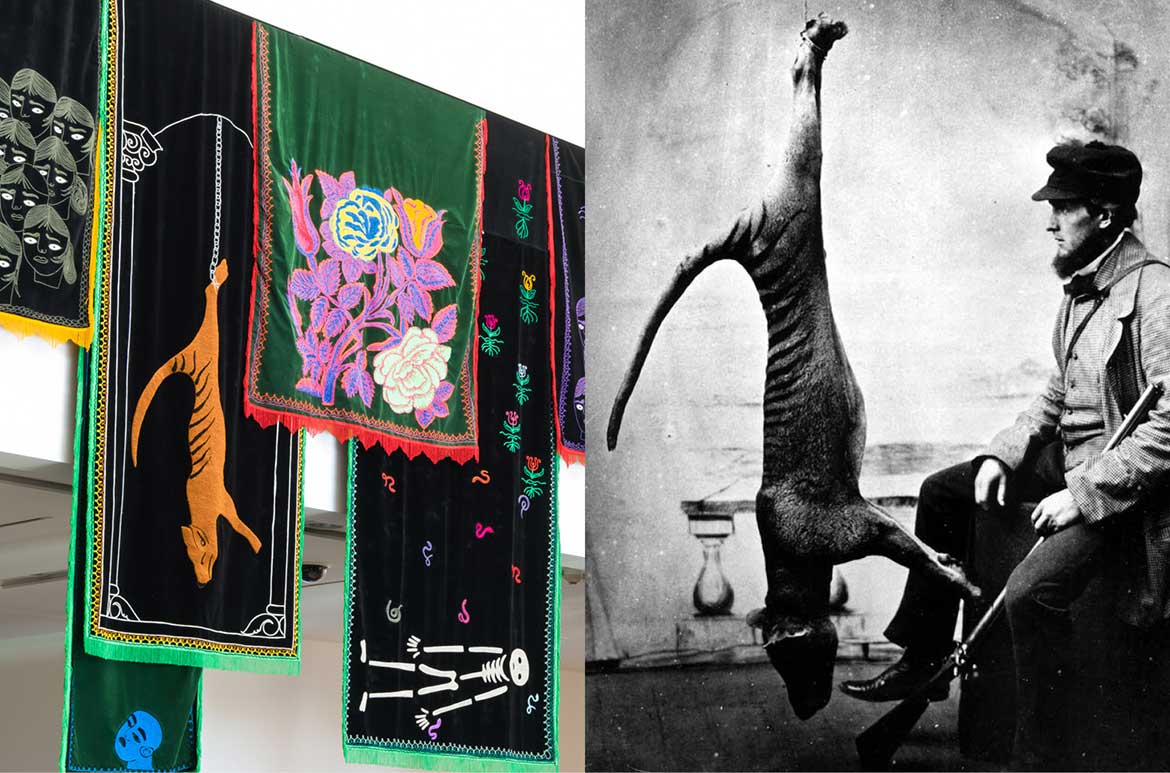
Raad’s APT9 commissions are steeped in art-historical references, sampled from across time and aesthetic lineages. Persia has a long history of painted and tiled murals; the earliest surviving examples date back to the first to third century CE, and the practice still continues today in Iran.2 Raad draws on this history of public art that engages with architecture in the design of his panelled mural, which works its way around doorways and stretches up towards the ceiling. Raad also alludes to South Asian truck painting, most overtly in the repeated eyes throughout the mural, which in their original context reference ‘bride eyes’.3 He was struck by the way that these trucks are like mobile galleries, and Days of bliss and woe is intended to be observed by visitors on the move — while the work can be glimpsed from the foyer and walkways below, the mural comes into full view as visitors ascend the escalator to the upper level. The artist was also interested in how contemporary truck painting encapsulated the movement and transformation of artistic practices. The South Asian truck paintings are inspired by Mughal painting, which developed from Persian miniature painting. This Persian influence can particularly be seen in Raad’s inclusion of birds, which he has merged and adapted to create new species.
The conventional timeline of a singular canon of great Western artists no longer holds as a mode for understanding art history. Incorporating political, religious, folk and academic artistic practices, Iman Raad’s artworks embody the explosion of references that influence our contemporary understanding of art. Reflecting our cosmopolitan and technologically connected moment, in both Days of bliss and woe and Garden nights, the diversity of global art history becomes ever present.
Ellie Buttrose is former Associate Curator, International Contemporary Art, QAGOMA.
The author would like to acknowledge that the ideas in this essay are indebted to numerous conversations with the artist that took place via email, Whatsapp, Facetime and Skype in 2017–18.
Endnotes
1 Bryony Stone, ‘“A moment of disturbance to reality”: artist Iman Raad on his latest work’, It’s Nice That, 30 August 2017, <https:// www.itsnicethat.com/articles/iman-raad-art-300817>, viewed January 2019.
2 Sheila R Canby, ‘Mural Painting’, Encyclopædia Iranica [online edition], 2015, <http://www.iranicaonline.org/articles/muralpainting>, viewed January 2019.
3 Jamal J Elias, On Wings of Diesel: Trucks, Identity and Culture in Pakistan, Oneworld, Richmond, 2011, p.129.
‘The 9th Asia Pacific Triennial of Contemporary Art’ (APT9) / Queensland Art Gallery | Gallery of Modern Art / 24 November 2018 until 28 April 2019
Featured image detail: Iman Raad Days of bliss and woe 2018 / Photograph: Natasha Harth © QAGOMA
#QAGOMA
